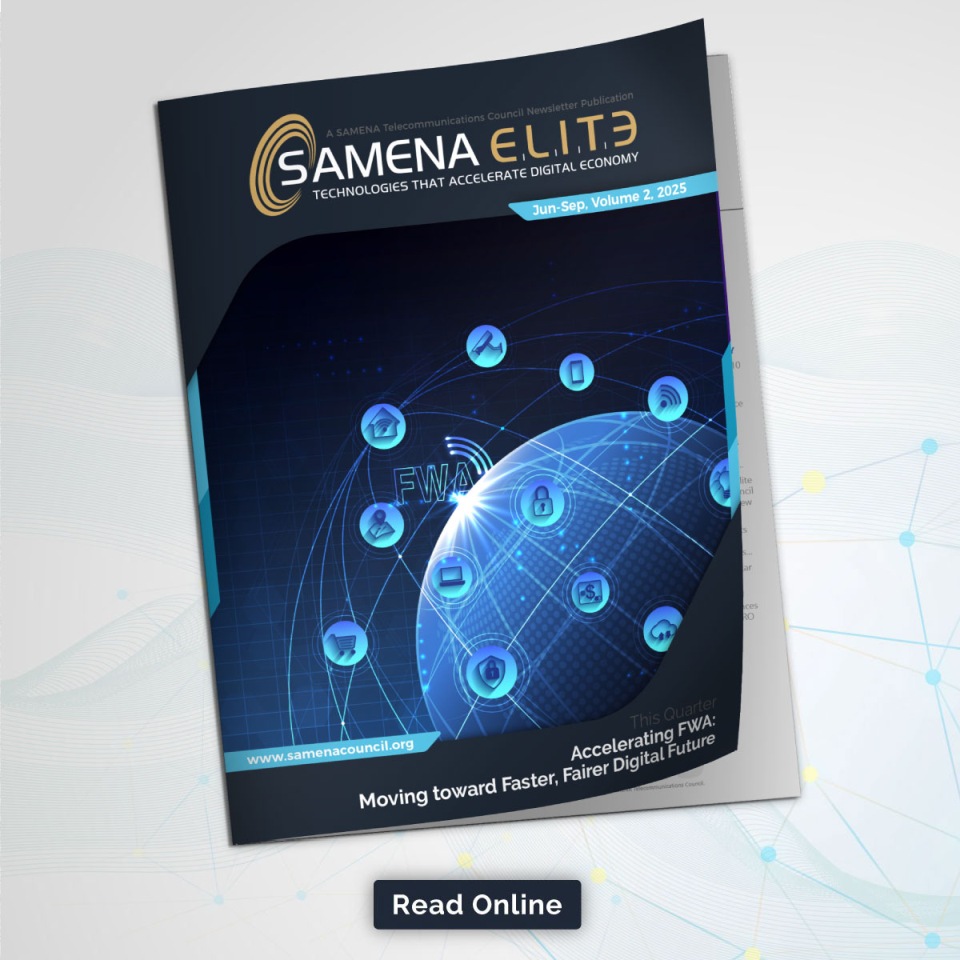Industry Thought Leadership
Thriving in the Intelligent Era: Empowered by Techco 1.0
May, 2025Intelligent technologies are rapidly advancing, driving AI adoption across industries and consumer markets. DeepSeek's open-source success and cloud market growth, are key indicators. The compound annual growth rate (CAGR) of the global public cloud market reached 19% in 2024. Many hyperscalers, such as Huawei Cloud, have also launched training and inference services.
Huawei's Techco 1.0 framework signifies a critical evolution for the telecommunications industry, empowering telcos to effectively navigate the complexities of digital transformation and capitalize on emerging opportunities.
The Middle East and Central Asia are leveraging connectivity technologies to stimulate demand for digital and intelligent operations. In 2024, the region united in its pursuit to become the world's first 5G Advanced (5G-A) region, with many countries releasing dedicated digital and intelligence strategies, such as Saudi Arabia's 10Gbps Society Initiative and the UAE's Strategy for Artificial Intelligence. These digital initiatives are further accelerating the broad adoption of AI, 5G, and cloud. Consequently, telcos across the Middle East and Central Asia are actively repositioning themselves to thrive in this digital and intelligent era.
Inspired by the region’s leading telcos' prominent "Techco" proposal in 2022, many other major players have since released similar transformation strategies, which focus on core business growth, operational agility, and expanding into areas like fintech, cloud, data centers, and industry digitalization.
Supporting this transformation, Huawei unveiled the Techco 1.0, as a common reference framework. This initiative aims to accelerate telecom companies' transition from traditional connectivity providers to Techcos – technology-driven companies.
Techco 1.0: a comprehensive framework facilitating a seamless transition to a Techco model
The Techco 1.0 framework aims to transform telcos for the digital future and growth. Techco 1.0 is built through three paradigms: servitization (everything-as-a-service), platformization (moving operations from silo to a unified digital platform), and intelligentization (evolving telcos' technology infrastructure to prepare for the age of AI).
Through these paradigms, the Techco 1.0 framework delivers well-defined approaches that help telcos grow core services, create new innovative digital services, all built upon a 3A (5G-A/F5G-A, Always-online, and AI-driven) digital and intelligent infrastructure to drive business growth in the intelligent era.
Traditionally, MBB and FBB core services account for significant revenue streams for telcos. During the transition to the Techco model by the Techco 1.0 framework, these revenues have the potential for steady development along three key directions:
- Extend monetization dimension: recent market research indicates that a significant 40% to 70% of consumers are willing to pay for enhanced online experiences, spanning enterprise applications, video streaming, live broadcasts, and gaming. Recognizing this substantial demand, it's crucial for telcos to adopt a multi-dimensional approach to MBB/FBB monetization by exploring and cultivating the requirements of higher-tier users. As telcos upgrade their technologies and operations platforms, they unlock the ability to monetize connection speed, latency, and uplink capabilities, a strategy already proven viable in the Middle East and Central Asia. These evolving monetization models have created mutual benefits for both users and telcos. Meeting specific user needs, telcos have delivered more predictable experiences and improved service perception, particularly for VIP users as evidenced by their VIP identity, consequently increasing ARPU, boosting VIP user retention, and enhancing telco competitiveness.
- Extend user scenarios: consumer digital lifestyle demands are evolving beyond simple connectivity, presenting significant opportunities for telcos to increase their share of the consumer's spending through scenario-driven services. This can be realized by enhancing current offerings, such as upgrading optical network terminals (ONTs) to FTTR and set-top-box (STBs) to AI home hubs, alongside promoting home storage solutions. Furthermore, telcos should develop compelling cloud services like cloud storage and video surveillance. Ultimately, building a robust ecosystem is crucial, leveraging their existing channels and platform capabilities to facilitate the sale of integrated products and services, such as integrated IoT solutions, layered on their core mobile and fixed broadband communications. By prioritizing product and service innovation, telcos can transition from competing solely on their installed base to creating new value, strengthening user loyalty, and driving revenue growth.
- Extend operation effect: facing evolving O&M challenges due to the continuous evolution of their core businesses and network telcos must embed AI into operations, as this will better position them to not only improve the operational efficiency but also maximize the benefits yielded by these improvements. This shift from efficiency-focused efforts to benefits-focused can be achieved in two phases. The first phase has telcos automate the management of their three value streams by shifting from network KPIs to customer experience index (CEI); applying AI for better complaint handling; and using AI for efficient fault processing. The second phase of this shift will have telcos build synergies across experience, maintenance, and network optimization processes, enhancing brand image and reducing service loss. Infusing AI into operations not only helps telcos better meet user expectations, but also helps improves O&M efficiency, minimize service loss, and enhance brand perception.
Consumer digital lifestyle demands are evolving beyond simple connectivity, presenting significant opportunities for telcos to increase their share of the consumer's spending through scenario-driven services.
Beyond the development of core services, telcos must capitalize on their existing strengths, such as connectivity infrastructure and established customer bases to expand their service portfolios. This involves the rapid development of new and innovative digital services to enhance their influence in the intelligent digital era. Referring to Techco 1.0 framework, innovative service development can be achieved through three key directions:
- New entries for digital life: in the digital age, many telcos struggle with customer loyalty, allowing OTT providers to capture significant content value and achieve higher profits. However, telcos possess a unique opportunity to establish new entries in AI and payment services, leveraging their local market knowledge and technical strengths. With new AI applications emerging daily, telcos are uniquely placed to create entry points for users wanting to access this vast array. In addition, the fact that 27% of adults globally lack bank accounts and 50% lack credit cards presents a clear demand for accessible digital financial solutions. Exploring four services—New calling, Fintech solutions, Home AI Hub, and cloud-based mobile phones—can create these entry points. Each allows telcos to provide a rich array of digital lifestyle services, reimagining access to the digital and intelligent world.
- New integrated ICT solutions for industries: industry digitalization presents a significant market, yet telcos face competition from cloud providers offering greater agility and integrated network solutions as part of their portfolio. To enhance competitiveness in the intelligent era, telcos must develop an agile, service-oriented strategy, leveraging network assets, advanced technologies, and enhanced cloud solutions. Traditionally, telcos have provided connectivity and data centers to OTTs and enterprises, acting as infrastructure providers. The new strategic focus for telcos is to deliver one-stop services such as managed Wi-Fi, Ideahub, and storage, requiring teams with lightweight IT integration capabilities. The ultimate stage involves delivering integrated data, information, and communications technology (DICT) services for industries based on cloud computing, AI, private networks, and collaborative ecosystems. Telcos can achieve unique competitiveness in the B2B field by transitioning from resource-based to integration-based providers, enabling them to lead the digital transformation of industries through network-cloud-intelligence synergy.
- New monetization models for data asset: telcos possess a significant asset in their extensive user data, the revenue potential of which has historically been underexploited. In the evolving digital landscape, telcos can establish a novel paradigm for data monetization through the implementation of robust data management practices with B2B2C. To achieve that, telcos will first need to transition from silo data management to unified management, which will allow them to process data as a standardized asset. This will improve data governance efficiency and utilization, as well as significantly reducing the time for market analysis and decision-making. Once data is managed as an asset, it can be better monetized. Externally, this can facilitate targeted marketing campaigns for new services and enable the development of specialized, and tailored data dashboards for various verticals.
- By adopting the Techco 1.0 framework, telcos can also be guided on advancing their ICT infrastructure to effectively monetize AI technology. The key technological considerations for this advancement can be strategically approached through the 3A network orientation: 5G-A/F5G-A, Always-online connectivity, and AI-driven network.
- 5G-A/F5G-A: wireless and fixed networks advances are crucial for the AI growth, providing performance, improved connectivity, scalability, and efficiency. These networks support the giga experience everywhere, high demands of AI workloads, enabling real-time applications, seamless data transfer, and fostering innovation. Techco transformation is driving advancement of 5G-A/F5G-A with ultra-broadband, ultra-latency, deterministic experience and intelligent sensing as the experience standard.
Always-online: as 5G-A/F5G-A brings full-service access capabilities, connecting people, home and things, the whole network needs to be more resilient and reliable. ensuring full-time service online. The approach is to design it with advanced architecture standards. The access network focuses on connectivity, where edge experience, uplink speed, positioning and latency capabilities are crucial. The transport network emphasizes high reliability and security through hardware, software, and protocol collaboration, while the core network is built for ultra-stability, focusing on security, redundancy, and fault resistance. - AI-driven: to make the most benefit, telcos need to advance AI strategy comprehensively, evolve services, network and operations towards AI. Leading telcos are introducing copilots and AI agents into high-value scenarios, proving their ability to ensure service development and improve user experience. A future-proof infrastructure is to develop DCs, cloud and computing centers ready for AI. Pioneers in East Asia market are striving for a significant role as open LLMs delivers leading performance, starting from internal but evolving to be a key enabler for society.
Techco 1.0 framework benefits
- This evolution is essential due to the swift advancement of digital services, evolving consumer expectations, and the overall expansion of the digital economy. The Techco 1.0 framework offers a comprehensive strategy for meeting the demand and growing overall business in the intelligent era. By focusing on business servitization, platformization, and intelligentization, Techco 1.0 equips telecom telcos to better manage business complexities, adapt to the fast-paced technological landscape, and improve customer engagement. It supports a gradual transition from legacy systems, allowing telcos to introduce advanced intelligence and agility without disrupting existing services. By materializing Techco 1.0 framework, telcos can pursue business growth by expanding core services, and launching innovative digital services, built upon a modernized 3A network to support sustained growth in the intelligent era.
- The strategic integration of AI across network management, predictive maintenance, and customer interactions is projected to reduce operational costs, freeing up resources for growth-focused investments. Furthermore, AI-powered service personalization will enhance customer satisfaction and improve customer retention.
Infusing AI into operations not only helps telcos better meet user expectations, but also helps improves O&M efficiency, minimize service loss, and enhance brand perception.
Conclusion: transforming telcos for the new and intelligent era
Huawei's Techco 1.0 framework signifies a critical evolution for the telecommunications industry, empowering telcos to effectively navigate the complexities of digital transformation and capitalize on emerging opportunities. By strategically adopting AI, 5G-A/F5G-A technology, and cloud platforms, telcos can transition from traditional connectivity providers to innovative technology companies - techcos. This transformation does not only generate new revenue streams for telcos to assume a more prominent role within the digital economy, but also to improve operational efficiency.
As the telecommunications landscape continues its rapid evolution, strategic initiatives such as the Techco 1.0 framework will be instrumental in shaping a future where telcos are at the forefront of digital innovation. It provides a strategic pathway for telcos to thrive in an increasingly interconnected world, establishing a foundation for a resilient and technology-driven future in intelligent era.

